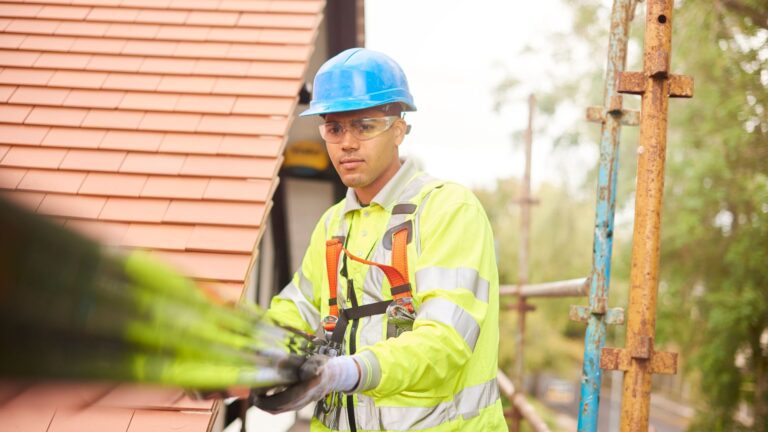Water pooling near the foundation of your home may seem like a minor inconvenience after a heavy rain, but it can lead to serious and costly damage over time. Persistent moisture around the base of your house weakens the soil and puts pressure on the foundation walls, eventually leading to cracks, shifting, or even structural failure. Foundation water damage isn’t just a cosmetic issue—it can threaten the safety and stability of your entire home. In addition, the damp conditions caused by water pooling near the house can invite mold growth, basement flooding, and pest infestations.
One of the most overlooked causes of this problem is faulty or poorly maintained gutters. When gutters are clogged, broken, or improperly installed, they fail to direct rainwater away from your home, allowing it to collect around the foundation instead. Over time, these gutter issues silently contribute to the deterioration of your foundation without you even realizing it. Addressing gutter problems early on can be a simple yet effective way to prevent foundation water damage and maintain the long-term health of your property.
Table of Contents
What Exactly Is Water Pooling Around a Foundation?
Water pooling around a foundation refers to the accumulation of standing water near the base of your home, often after rainfall or improper drainage. This stagnant water typically results from a drainage problem, such as poor grading, clogged gutters, or broken downspouts. While it may seem harmless at first glance, water pooling around foundation areas can signal deeper issues that require immediate attention.
In the short term, standing water near a house can lead to soggy soil, unpleasant odors, and increased mosquito activity. However, the long-term impact is far more serious. Prolonged exposure to moisture can cause the soil beneath your foundation to expand and contract, leading to cracks, uneven settling, and costly structural damage. If left unaddressed, a minor drainage problem can escalate into a major threat to your home’s stability and value.
Over time, continuous water pooling around foundation areas can also weaken concrete and seep into basements or crawl spaces, resulting in interior water damage and potential mold growth. This not only compromises the structural integrity of your home but can also affect indoor air quality and your family’s health. Identifying and resolving the source of standing water near your house—whether it’s poor yard grading, faulty gutters, or another drainage problem—is essential to protecting your home from long-term deterioration.
Why Gutters Play a Critical Role in Foundation Protection
Gutters as the First Line of Defense Against Water Damage
Gutters are a crucial component of any home’s rainwater management system. By channeling rainwater away from the roof and foundation, they help prevent excess moisture from accumulating around the base of your home. Effective gutter drainage reduces the risk of erosion, basement leaks, and long-term foundation damage. Without this first line of defense, even a moderate rainstorm can lead to standing water around your home’s perimeter. In short, properly functioning gutters are essential for long-term foundation protection and overall structural health.
How Improper Drainage Affects Your Foundation
Poor gutter drainage allows water to overflow and pool near the foundation.
Standing water around the home’s base can saturate the soil, leading to uneven pressure and potential cracks.
Continuous moisture weakens foundation materials, increasing the risk of shifting or settling.
Inadequate rainwater management can lead to basement leaks, mold growth, and structural instability.
A compromised drainage system undermines foundation protection, resulting in costly repairs and potential safety hazards.
Top Warning Signs Your Gutters Are Causing Drainage Issues
Overflowing gutters during rainstorms – A clear sign of clogged gutters or poor drainage, causing rainwater pooling near your home’s foundation.
Water stains on exterior walls or foundation – These stains often indicate that water is spilling over instead of being properly directed away, pointing to potential gutter damage signs.
Pooling water around downspouts – When downspouts fail to carry water far enough from the house, it can lead to standing water and possible foundation issues.
Soil erosion or visible dips in the ground – Erosion near the base of your home may signal improper drainage caused by clogged gutters or broken components.
Sagging or detached gutters – This is often caused by excessive weight from debris or standing water, reducing effective rainwater pooling control.
Cracks in your home’s foundation – Prolonged exposure to improperly managed water can create pressure that weakens the foundation over time.
Basement leaks or dampness – One of the most serious outcomes of gutter drainage problems, often linked to rainwater seeping through the foundation.
Peeling paint or rotting trim – Water that spills over damaged gutters can affect exterior surfaces, indicating a bigger issue with gutter damage signs.
Mildew or mold near the base of your home – Persistent moisture from pooling water fosters fungal growth and signals ineffective water redirection.
Gutters filled with debris or plants – Obvious clogged gutters not only look unkempt but also block proper water flow, leading to serious drainage issues.
Other Causes of Water Pooling (Besides Gutters)
1. Poor Landscaping Drainage
While gutters are a major player in water control, poor landscaping drainage can also contribute significantly to water pooling around your home. If your yard isn’t designed to channel water away from the structure, it can result in standing water that slowly seeps into your foundation. Lack of proper drainage channels, swales, or catch basins can allow water to collect in low-lying areas, putting your home at risk for long-term moisture problems.
2. Improper Yard Grading or Slope
The slope of your yard plays a crucial role in directing rainwater away from your home. If your yard slopes toward the house instead of away from it, rainwater will naturally flow back toward the foundation. This common grading issue can result in continuous saturation of the soil near the base of your home, which increases the risk of structural damage. Addressing yard slope is key to preventing water accumulation.
3. Broken or Short Downspouts
Downspouts that are too short or broken fail to carry water far enough away from your home. As a result, water is discharged too close to the foundation, leading to puddling and erosion. Even with a functioning gutter system, short or damaged downspouts undermine the entire drainage process. Extending or repairing them is an easy yet critical step in preventing water-related damage.
4. Cracked Underground Drainage Pipes
Hidden drainage pipe issues, such as cracks or collapses underground, can cause major problems over time. These pipes are designed to move water away from the home efficiently, but when damaged, they can leak or back up, resulting in water pooling near the foundation. Since these problems aren’t visible at the surface, they often go unnoticed until serious symptoms appear.
5. Hardscapes Directing Water Toward Foundation
Patios, walkways, and driveways that slope toward your house can act as channels, directing water straight to the foundation. These hardscapes often contribute to rainwater pooling near the home, especially during heavy storms. If not properly graded or drained, they defeat the purpose of your exterior drainage system and create significant foundation risks.
What Happens If You Ignore It? Real Consequences
Ignoring water pooling around your home can lead to serious and costly consequences. One of the most significant risks is structural damage, including foundation cracks and uneven settling. Over time, this damage may require extensive foundation repair, which can cost thousands of dollars depending on the severity. Water that consistently seeps into your basement can also cause basement water damage, resulting in ruined flooring, damaged walls, and a compromised living space. These issues not only threaten the stability of your home but also significantly reduce its value.
Beyond structural damage, persistent moisture creates the perfect environment for mold growth and poor indoor air quality. Mold from water pooling often spreads quickly in damp, dark areas like basements and crawl spaces, posing health risks to your family—especially those with allergies or respiratory conditions. Additionally, standing water can attract rodents and pests, which are drawn to excess moisture and can create further problems inside your home. Addressing these issues early is far less expensive than dealing with the long-term effects of neglect.
How to Diagnose Gutter-Related Drainage Problems
Diagnosing gutter-related drainage problems early can save you from expensive repairs and long-term structural damage. A thorough gutter inspection checklist helps you spot early warning signs like overflowing gutters, sagging sections, or water pooling near the foundation. Many homeowners overlook these issues until foundation damage or basement leaks occur, but regular monitoring can help you find drainage problems before they escalate. Observing your gutter system during and after rainstorms is a simple yet effective way to assess how well it’s managing water.
In addition to visual checks, using basic tools and techniques can help confirm whether your gutters are functioning properly. A foundation water test using a garden hose, for example, can help simulate rainfall and reveal problem areas around downspouts or grading. If you’re unsure about what you’re seeing or suspect a hidden issue like a cracked drainage pipe or improperly sloped yard, it may be time to bring in a professional. A licensed expert can inspect the entire drainage system and offer targeted solutions.
Visual Inspection Tips
Look for sagging or detached gutter sections
Check for visible clogs or debris buildup
Inspect downspouts to ensure they extend away from the home
Examine exterior walls for water stains or peeling paint
Look for soil erosion or pooling water near the foundation
Using Water Tests or Hose Checks
Run water through gutters to check flow and identify blockages
Observe if water overflows at specific points
Test downspouts to ensure water is being directed far from the foundation
Watch for water accumulating near the base of the house during the test
When to Schedule a Professional Inspection
If you see recurring water pooling near your home
When visual checks don’t reveal the full cause of the problem
If gutters or drainage systems are outdated or damaged
Before or after major storms to assess potential damage
If you’re planning a foundation water test and want expert input
Best Gutter Solutions to Prevent Water Pooling
Investing in the right gutter upgrades can significantly reduce the risk of water pooling around your foundation. Seamless gutters are a smart choice because they reduce the chances of leaks and clogs compared to traditional sectional systems. Adding gutter guards further enhances performance by preventing leaves and debris from blocking water flow. These improvements ensure that rainwater is efficiently directed away from your home, keeping your drainage systems working smoothly and protecting your foundation from long-term moisture exposure.
Another effective way to manage water flow is by installing downspout extensions or splash blocks. These help guide water further away from the foundation, minimizing soil erosion and puddling. For homes in areas prone to heavy rainfall, integrating additional drainage systems like French drains or rain barrels can provide overflow control and reduce pressure on your gutters. These solutions not only improve rainwater management but also contribute to the overall health and stability of your property.
Gutter Maintenance Tips for Long-Term Protection
Regular gutter maintenance is essential for preventing water damage and protecting your home’s foundation. Clogged or damaged gutters can lead to rainwater overflow, soil erosion, and costly structural issues. By following smart gutter maintenance tips, you can extend the life of your gutter system and keep your home safe from drainage-related problems. As part of your seasonal home care, it’s important to inspect and clean gutters regularly, especially before and after major weather changes.
Neglecting your gutters not only puts your roof and siding at risk, but it also compromises your home’s drainage system. Whether you choose to handle the task yourself or hire a professional, staying consistent with maintenance will prevent small issues from becoming major problems. A well-maintained gutter system supports proper water flow, minimizes debris buildup, and ensures your home remains protected year-round.
How Often Should You Clean Your Gutters?
At least twice a year—typically in spring and fall
More frequently if you have overhanging trees or experience heavy storms
After severe weather to check for clogs or damage
DIY vs. Professional Gutter Cleaning
DIY is cost-effective and manageable with proper safety gear
Professionals have the tools and expertise to spot hidden damage
Hiring a service is ideal for multi-story homes or hard-to-reach areas
Pros may also offer inspections and minor repairs during cleaning
Seasonal Maintenance Checklist
Clear out leaves, twigs, and debris
Check for rust, holes, or sagging sections
Ensure downspouts are firmly attached and flowing properly
Inspect gutter guards for blockages
Look for signs of water damage on siding or foundation
Conclusion:
Addressing gutter issues early is one of the simplest and most effective ways to protect your home from serious water damage. What starts as a minor clog or misaligned downspout can quickly escalate into foundation cracks, basement flooding, or costly mold remediation. Taking the time to invest in proper gutter drainage, regular maintenance, and small repairs can prevent the need for expensive fixes later on. Your home’s foundation, structure, and indoor environment all benefit from a well-functioning gutter system.
Regular inspections—especially during seasonal transitions—can help you catch small problems before they turn into major expenses. Whether it’s cleaning out debris, extending downspouts, or repairing loose gutter sections, these routine tasks go a long way in preserving your home’s integrity. With consistent upkeep and attention to early warning signs, you’ll enjoy peace of mind and long-term savings by avoiding preventable water damage.







